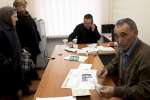- Text size
 |
|  |
|  |
| 
- Français
Viet Nam ends stateless limbo for 2,300 former Cambodians
News Stories, 19 July 2010
HO CHI MINH CITY, Viet Nam, July 19 (UNHCR) – In a joyous citizenship ceremony, Viet Nam took a ground-breaking step towards closing the last chapter in a 35-year-long statelessness saga for some 2,300 former Cambodians.
"I'm so happy," said a beaming Luong Ve, 77, the oldest among 287 former refugees to receive a Vietnamese naturalization certificate last Friday, a valuable document that will now entitle him to a huge number of rights others take for granted.
It is the culmination of UNHCR's efforts, together with the Vietnamese government, to resolve one of the lingering legacies of Cambodia's bloody 1970-75 Pol Pot regime. The 2,357 former Cambodians who will receive citizenship had fled in 1975 to Viet Nam, where they learned the language and fully integrated into their new country.
The 287 naturalized on Friday in the southern Vietnamese city formerly known as Saigon, live in what used to be two refugee camps set up by UNHCR in 1980. The rest are on track to get their papers by the end of this year.
"This sets an excellent example in the region for resolving statelessness and is a great way to start commemorating the 50th anniversary of the 1961 Convention on the Reduction of Statelessness," said Thomas Vargas, UNHCR's regional protection adviser, who attended the ceremony. He encouraged other Asian countries to take a lead from Viet Nam in finding solutions for statelessness.
Last year, Viet Nam also enacted a new law to plug gaps that had left thousands of women stateless after they married and divorced foreign men.
The valuable new citizenship documents – handed out on a flag-draped stage at Ho Chi Minh City's Department of Justice – will confer the all-important family registration book and ID card that will open the door to health and social insurance, buying a house, higher education and better jobs.
Ho Manh Cong, whose family came to Viet Nam in 1975, was born in Ho Chi Minh City 28 years ago but has never even been able to own a motorbike because he is not a citizen.
"Not having Vietnamese citizenship has created a lot of troubles in my daily life," he said. "I've been working for a company for more than five years but still cannot enjoy social insurance."
For Vu Anh Son, head of UNHCR's operations in Viet Nam, the ceremony was nearly as emotional as for the 287 receiving their certificates.
"I have known most of these people for 10 years," he said. "All they wanted was for UNHCR to help them obtain legal status so that they could live in Viet Nam permanently because there was no other solution that would give them a good future."
"This is what I have been working on with the government of Viet Nam for five years. I'm so thrilled to share the happiness with all the people with citizen certificates in their hands."





































